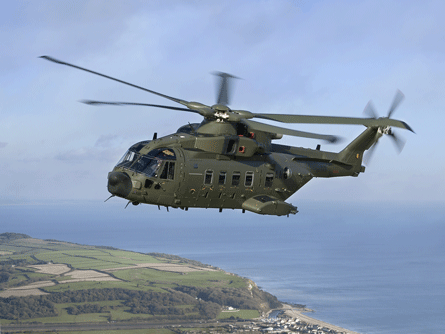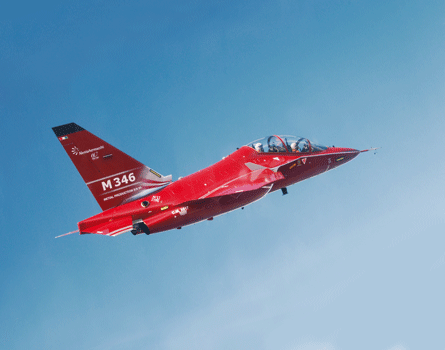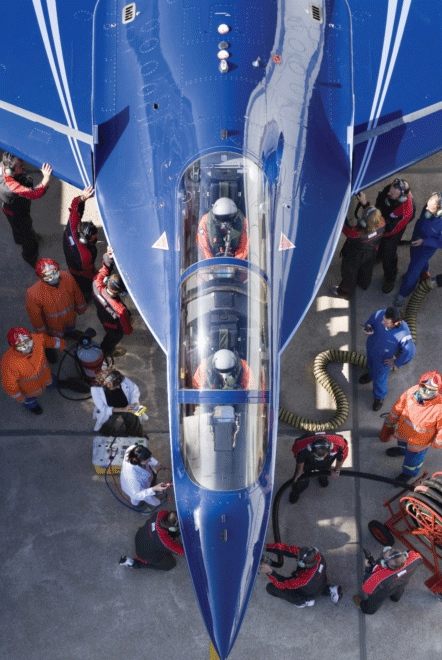Facing the rows of Afghans, Americans and Italians assembled inside a spacious hangar a few kilometres south of Naples, the head of Alenia North America saluted the workers who salvaged the company's riskiest move yet to penetrate the lucrative US defence market.
Behind chief executive Giuseppe Giordo on 25 September sat a G222 light transport that once hauled cargo for the Italian air force. It would be the first of 18 G222s to complete refurbishment and be delivered to the Afghan national army air corps.
Giordo's ultimate customer, however, was not the Afghans in the room. The US Air Force awarded the contract to Alenia in September 2008. In both legal and symbolic terms, Alenia considers the G222 order a major breakthrough with strategically the USAF its most important customer.
To be sure, by US defence industry standards, the contract's $287 million price tag was minuscule. It was only one-tenth the size of the original Joint Cargo Aircraft contract awarded in 2007 to an L-3 Communications/Alenia Aeronautica team. But the Afghan G222 deal's strategic value to Giordo's company - and corporate parent Finmeccanica - far out-measured the profit margin.
Never before had a Finmeccanica business unit enjoyed "prime contractor" status for a deal with the US military. Alenia and AgustaWestland have previously sold aircraft to the Department of Defense and other US agencies, but only as subcontractors to a US-based "prime".
The difference between prime and subcontractor roles is not trivial for an aircraft manufacturer. Subcontractors not only lose the prime's share of the profit fee, but control of the aircraft configuration and supply chain.
Finmeccanica is in the process of making a strategic push into the US market. Highlights of the campaign so far include winning the JCA deal as a subcontractor to L-3 and the $5.2 billion acquisition last year of DRS Technologies.
But the US market push has also faced major setbacks. A decade ago, Aermacchi lost a bid to supply the MB-339 jet trainer to become the joint primary aircraft training system (JPATS). In 2004, the US Army prevented AgustaWestland from competing for the armed reconnaissance helicopter contract.
Then, when the US Navy selected Lockheed Martin to supply the AgustaWestland EH101 as the next presidential helicopter in 2005, the deal was hailed as a major breakthrough. But the deal was terminated four years later, the victim of breakdowns in the acquisition system that caused costs to spiral out of control.
 |
|---|
© FinmeccanicaCost spiral killed AgustaWestland AW101 as basis for US presidential helicopter |
Winning the G222 deal seemed to mark a change in the company's fortunes. Finmeccanica believes growth in the US market could accelerate in the next four years. Giordo's business unit, Alenia North America, plans to surpass $1 billion in annual sales by 2013. The C-27J programme now faces great uncertainty, but its potential upside remains huge.
A competition for a multibillion dollar deal to supply hundreds of new trainer jets is on the horizon. If all goes as planned, the USA will join Italy and the UK as Finmeccanica's third host country.
All of those expectations weighed heavily on the tiny G222 programme. Finmeccanica executives knew they could not afford a cost overrun or a major schedule delay on its first prime contract. The US military records how contractors perform, and poor marks damage future bids.
Alenia later acknowledged facing unexpected challenges. The G222s arrived at Alenia's factory in Capodichino requiring far more work than the company's engineers had predicted. Alenia absorbed the financial impact of a 150% increase in contract work scope, rather than passing the extra cost to the customer, says Col Tim Freeman, commander of the USAF's 330th aircraft sustainment wing.
After the G222 delivery ceremony in the Alenia factory Freeman said: "I am very impressed. They did exactly what they said they were going to do."
Alenia also learned some hard lessons about the paperwork that comes with the prime contractor role. The company found out after contract award that the Defense Contract Audit Agency would not accept their financial statements. Alenia's accounting system was based on European standards. The DCAA would only accept cost and pricing data submitted under a US accounting format.
For Alenia, it was no small discrepancy. The US government refused to make progress payments until Alenia converted to the US accounting style. Alenia officials agreed to internally finance the programme for nearly nine months, a big departure from Finmeccanica's corporate practice.
In the end, Alenia delivered the first aircraft exactly on schedule. Although Alenia's internal costs grew significantly, the USAF customer did not feel the impact. As Giordo explained to his employees gathered inside the hangar, the first G222 delivery sent a critical message to the US military's acquisition community.
"We are showing," Giordo said, "to the biggest customer of the world that we can do it."
About 820km (500 miles) north of the G222 delivery ceremony in Capodichino, Alenia executives in Varese, Italy, however, are still wondering if they really can - or should.
The Air Education Training Command (AETC) plans to award a contract in 2014 to replace about 550 ageing Northrop T-38C Talon trainers, a seemingly ubiquitous jet last produced in the early 1970s. A few years later, the US Navy also could start replacing its oldest Boeing T-45 Goshawk jet trainers. Meanwhile, the USAF also could start buying two-seat jets to serve as light strike fighters.
As one of the few new contracts scheduled for award in an otherwise bleak decade for sales projections, the size of the award makes it a priority for any aerospace company. But the T-X contract perhaps means more to Finmeccanica compared with the established US defence industry.
"It would be a cornerstone programme to win in the USA," says a senior Finmeccanica executive, who wishes to remain anonymous in compliance with company policy, "because it would establish Finmeccanica and Alenia Aeronautica as a core player in the US market."
Finmeccanica can offer the AETC a nearly completed product. Alenia Aermacchi plans to deliver the first M-346 Master to the Italian air force next year. The UAE also has selected the M-346 as a trainer and light strike fighter, although price negotiations are continuing.
 |
|---|
© FinmeccanicaM-346: looking for a US trainers deal |
For the T-X contract, the M-346 will almost certainly face familiar rivals in the Korea Aerospace Industries (KAI)/Lockheed Martin T-50 Golden Eagle and BAE Systems Hawk. Boeing, a partner with Alenia Aermacchi on international sales, could propose a "purpose-built" jet design for the T-X contract, according to industry sources.
|
|---|
© Alenia AeronauticaUS Air Force is seen as a potential buyer for up to 145 Alenia C-27Js |
Alenia's executive team believes the G222 experience proves it can operate in the US market at the prime level. The company now must decide whether the US customer is ready.
Alenia would clearly prefer to win the contract as a prime. Giordo says: "For the time being we are considering being prime contractor."
But the uncertainty of Alenia's position was underscored during a preceding press conference with Giordo's boss, Alenia Aeronautica chief executive Giovanni Bertolone.
Asked if Alenia could win the T-X contract as a prime, Bertolone did not immediately answer the question. Instead, he transformed the panel of US-based journalists into an impromptu focus group, sincerely asking for their opinion. The consensus reply was: "It depends." Bertolone followed that noncommittal answer by replying in similar fashion to the original question. The prime contractor role "is a matter we have to explore", he said.
Delivering a product as prime contractor for the G222 is one thing. But assuming the prime contractor role to compete against more established US primes for a prized, multibillion contract with global significance is quite another.
EADS North America proved in 2006 that a European-owned company could win in the USA at the prime level. The EC145 - now UH-72A Lakota - defeated rival bids from Bell Helicopter and MD Helicopter for the light utility helicopter contract.
The LUH award, however, arguably comes with an asterisk. The US Army is buying the UH-72A as a US Federal Aviation Administration-certificated civilian helicopter simply painted in military colours, not a combat-rated weapons system.
Moreover, the political backdrop for transatlantic defence industrial co-operation has shifted slightly since the LUH contract award.
Europe and the USA have each adopted more protectionist philosophies in the wake of the economic crisis that began in 2007. The clash between Airbus and Boeing over government subsidies and tanker sales has also intensified.
Giordo believes that Finmeccanica's strategy remains valid in the current environment. First, the strategy seeks to avoid competing directly with US prime contractors offering similar products, such as in the tanker competition. Second, Finmeccanica tries to establish an industrial presence in the USA with every contract victory. Finally, Giordo says, Finmeccanica now understand the rules and procedures for competing in the US market at both the subcontractor and prime levels.
"We still believe that the American market is probably the most important market for us in terms of dimension of the market and in terms of value," Giordo says.
If Alenia is still unsure whether it can assume the prime role, the company is certain that US-owned companies will play a significant role in the T-X bidding strategy.
According to Alenia executives, the US content in the M-346 is already between 45% and 52%, which includes Honeywell F124 engines. The Buy American law requires government equipment to be at least half-composed of US-made components. Alenia will attempt to build upon the M-346's existing US supplier presence, possibly with simulator, avionics and radar manufacturers.
"We realise we cannot do this on our own," the Finmeccanica senior executive says. "We'll need a US partner." Another major question Alenia faces before the T-X competition begins is where to assemble the M-346 on US soil.
The USAF wants to buy as many as 100 light attack and armed reconnaissance aircraft. A request for information published by the USAF in August appears to be aimed at acquiring a turboprop, such as the Hawker Beechcraft T-6 Texan or Embraer A-26 Super Tucano.
Alenia, however, believes there is also a need for an armed version of the M-346 to serve as an at least complementary system. The UAE plans to operate a portion of its M-346 fleet in the same role. Giordo says the USAF's need to operate in hot temperatures and high altitudes was driving the requirement for a jet.
"We know that other companies have offered a jet aircraft," he says. "So it's not just for turboprops."
If the USAF shows interest in Alenia's concept, the company will have to move fast. The USAF plans to field the aircraft in 2012, or at least two years before the earliest contract award date for T-X.
 |
|---|
© FinmeccanicaAlenia Aermacchi may bid as a prime contractor for the USAF's T-X contract |
Alenia has two acknowledged options. With the DRS acquisition, Finmeccanica gained an aircraft manufacturing plant in Elizabeth, North Carolina. Alenia also planned to open a final assembly plant in Jacksonville, Florida, to build the C-27J.
The latter facility is on hold after the JCA programme was transferred to the USAF, which promptly slashed the programme from at least 78 to 38 aircraft. Alenia's investment in the Jacksonville factor was predicated on a yearly production rate of nearly 19 aircraft a year. Justifying the cost of the investment is impossible with only 38 aircraft, Giordo says.
Despite the programmatic setback on JCA, company officials remain bullish about the light transport's potential in the US market. Alenia's public briefing materials still identify the USA as a potential buyer for up to 145 C-27Js. The USAF continues to review airlift fleet options, which has inspired hope at Alenia for a comeback.
Separately, the Air Force Special Operations Command could resume pursuit of a gunship variant. AFSOC planned to buy 16 AC-27Js to "complement" the much larger AC-130J, but cancelled the programme last year. The requirement for the aircraft still lives, however, Giordo says.
"I believe that the push [to restart the AC-27J acquisition] will be given directly by the special operations forces," he adds. "It will come from outside the corporate air force."
Enlarging the C-27J order could influence how Alenia proceeds on M-346. Alenia is considering combining production of both aircraft at the same site, Giordo says. Such a "mixed-use" factory could be based in Florida, North Carolina or elsewhere, he believes.
The company is also waiting for the USAF to clarify its requirements for the light attack and armed reconnaissance programme. An analysis of alternatives is scheduled to be complete in December, Giordo says. A second request for information could follow in the second quarter of 2010. That document should indicate whether USAF officials want to buy a jet or a turboprop.
"If I consider the next steps on the M-346 campaign I believe that by 2010 we will take the decision to launch our production facility," Giordo says.
Giordo dismisses the idea that an influx of foreign military sales could sway Alenia to invest in a US factory to handle the extra production work. "We can do something [to attract foreign orders], but we will never balance the original number that was coming from the joint cargo aircraft," he says.
Once again, Finmeccanica's strategy for sales growth starts and ends with the US market.
Source: Flight International

















